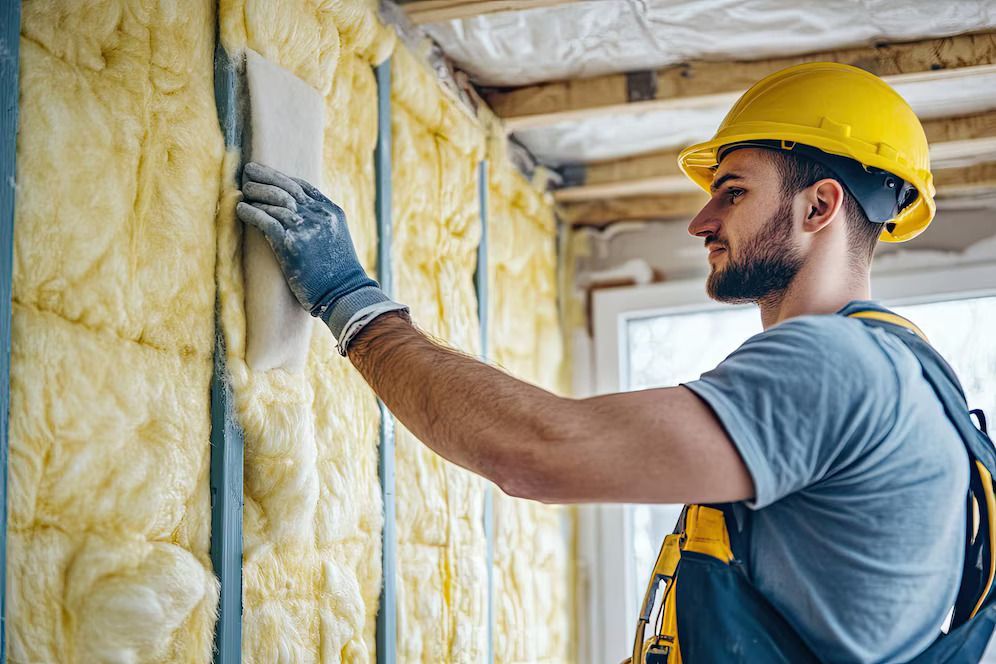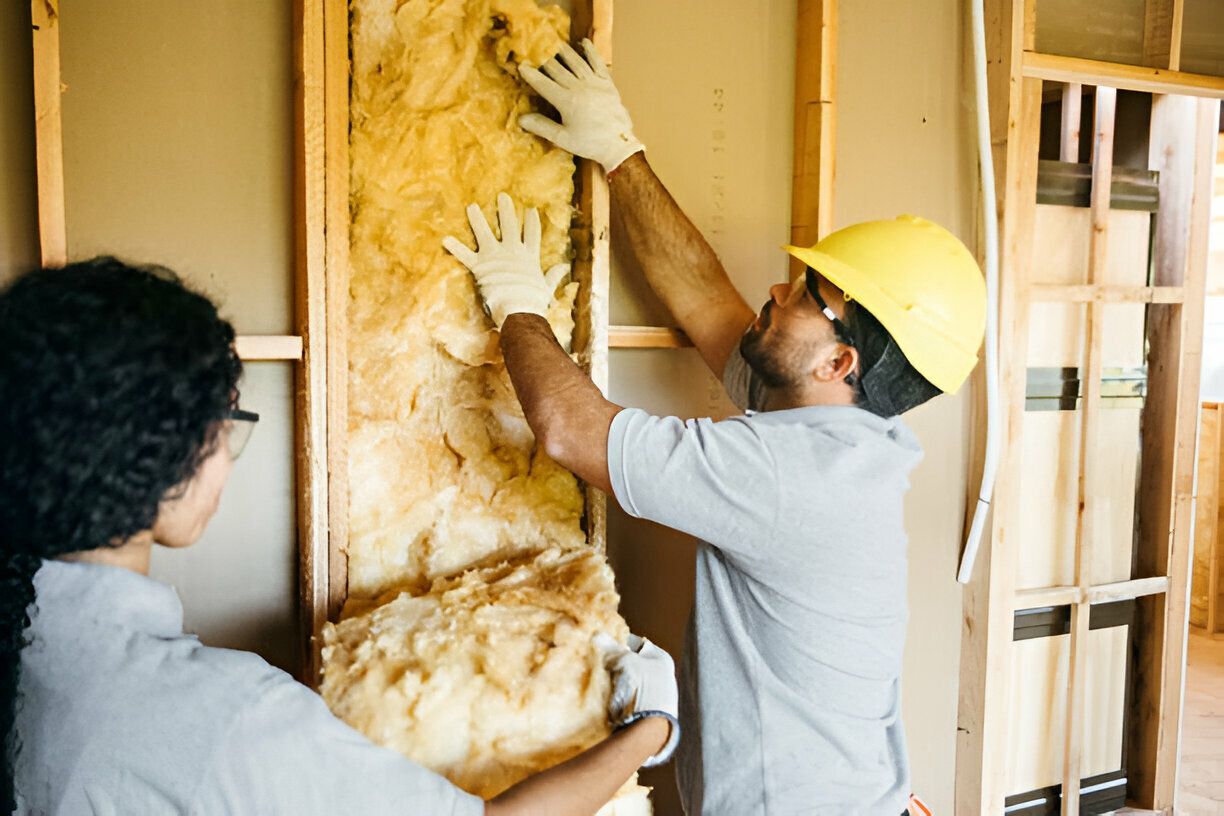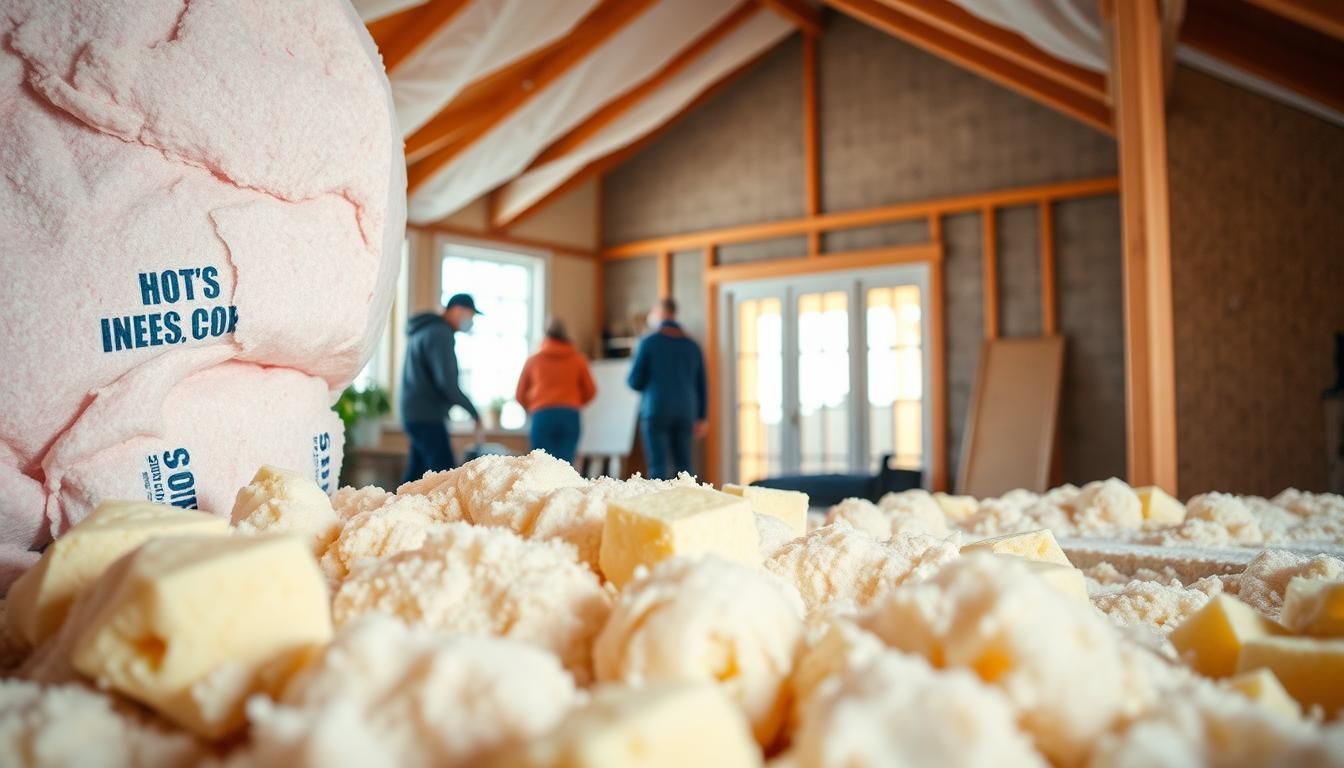Does Your Home Need Insulation Upgrades? Signs to Look For
Keeping your home comfortable and energy-efficient is key. Insulation is often overlooked but crucial. Inadequate insulation can raise your energy bills and lower your comfort. Insulation can wear out or get damaged over time. If you see drafts, uneven temperatures, or higher energy costs, it might be time for an upgrade. Upgrading your insulation can make your home more comfortable and energy-efficient.

Thinking about spray foam insulation services could be a good move. These services can spot where insulation is missing and offer solutions.
Key Takeaways
- Check for drafts and uneven temperatures in your home.
- Increased energy bills can indicate inadequate insulation.
- Consider professional assessment for insulation needs.
- Upgrading insulation can enhance home comfort and energy efficiency.
- Spray foam insulation services can provide effective solutions.
Understanding the Importance of Proper Home Insulation
Proper home insulation is key for a cozy and energy-saving home. It helps keep your home warm in winter and cool in summer. This means you don't have to use as much heat or air conditioning.

How Insulation Affects Energy Efficiency
Good insulation stops heat from moving in and out of your home. This cuts down on energy use and saves money on bills. It also helps the planet by using less energy.
Choosing the right insulation and installing it correctly boosts your home's energy efficiency. Plus, you might get tax breaks or other benefits for using energy-efficient insulation.
The Impact of Insulation on Home Comfort and Health
Enough insulation keeps your home's temperature steady and stops cold air from getting in. This makes your home more comfortable, especially for families with kids or the elderly.
It also stops moisture from building up, which means less mold and mildew. This is good for the air you breathe and keeps your family healthy.
10 Warning Signs Your Home Needs Insulation Upgrades
There are several signs that show your home's insulation might not be enough. Spotting these early can stop energy loss, cut down on bills, and keep your home cozy. Here, we'll look at the top 10 signs your home might need insulation upgrades.
Fluctuating Indoor Temperatures
Notice your home's temperature changing a lot? This could mean your insulation isn't working right. If temperatures vary from room to room or floor to floor, it's a sign of bad or damaged insulation. This leads to discomfort and higher energy use.
Unusually High Energy Bills
See your energy bills go up without using more? It might be because your home is losing energy. This is especially true when it's very hot or cold outside. Your heating or cooling system has to work harder to keep your home comfy.

Cold Walls, Floors, and Ceilings
Feel cold surfaces in your home, even with the heat on? This is a clear sign of insulation problems. Cold walls, floors, and ceilings mean heat is escaping. This could be because of gaps or not enough insulation.
Ice Dams on Your Roof
Ice dams on your roof in winter are a big warning sign. They happen when snow melts on warmer parts of the roof and then freezes at the colder edges. This can cause water damage.
Drafts Around Windows and Doors
Feel drafts around windows and doors? This is often a sign of air leaks, which can be linked to insulation problems. While sealing gaps is important, bad insulation makes drafts worse by letting cold air in.
Frozen Pipes in Winter
Frozen pipes are a risk in homes without good insulation, especially in unheated areas. Insulation keeps temperatures warm enough to prevent pipes from freezing and bursting.
Pest Infestations
Pests can be attracted to insulation, especially rodents in attic insulation. They can make insulation less effective and cause more damage.
Knowing these 10 warning signs helps homeowners take action. They can check their insulation and think about spray foam insulation services or other insulation upgrades. This improves energy efficiency, comfort, and the overall state of their home.
Identifying Insulation Problems in Specific Areas
It's key to spot insulation issues in your home's different spots for better energy use. Each area of your house needs its own insulation type. Ignoring these needs can cause big energy losses.
Attic Insulation Assessment
The attic is super important for keeping your home warm. Make sure there's enough insulation and it's spread out right. Look for damage like squished or wet insulation, which can make it less effective. If your attic isn't well-insulated, think about using better materials.
Wall Insulation Evaluation
Checking wall insulation can be tricky, but there are clues. Look for cold spots, drafts, or high energy bills. If you think your walls aren't well-insulated, get a pro to check them, especially before any big changes.
Basement and Crawlspace Insulation Issues
Basements and crawlspaces often face moisture problems, which hurt insulation. Make sure insulation here can handle moisture and is put in right. Watch for water damage or dampness and fix it before adding more insulation.
Garage and Bonus Room Considerations
Garages and bonus rooms, especially those over unheated areas, need special insulation care. They should be well-insulated to keep warmth in and cold out. Use insulation that also seals air well.
In short, finding and fixing insulation issues in your home can really boost energy efficiency and comfort. Regular checks and updates can stop energy waste and cut down on bills.
How to Inspect Your Home's Current Insulation
A thorough insulation inspection can uncover hidden problems. These issues can affect your home's energy use. Regular checks help find ways to make your home more energy-efficient, keeping it comfortable and affordable.
Visual Inspection Techniques
Start by doing a visual inspection of your home's insulation. Look at the attic, walls, and floors for damage, wear, or gaps. Check if insulation is compressed or missing, as this can lower its effectiveness.
Make sure insulation is spread evenly. Also, check for obstructions like wiring or ductwork that might affect its performance.
Using Thermal Imaging to Detect Insulation Gaps
Thermal imaging is great for finding insulation gaps and other hidden issues. It uses cameras to spot temperature differences in your home. This shows where heat is escaping.
By finding these spots, you can focus on improving insulation. This ensures your home is well-sealed and insulated.
When to Call a Professional for an Insulation Audit
While DIY checks are helpful, sometimes you need a professional for an insulation audit. If you're not sure about your insulation or think there might be big problems, a pro can help. They can give a detailed review, suggest fixes, and make sure any upgrades are done right and safely.
Types of Insulation Materials and Their Applications
Choosing the right insulation is key for a cozy home and saving energy. Homeowners need to think about how well it works, its cost, and its impact on the environment. This helps pick the best insulation for their homes.
Traditional Insulation Options
Fiberglass and cellulose have been used for years. Fiberglass is affordable and good at stopping heat. Cellulose, made from recycled paper, is eco-friendly and works well too. They're good for walls and attics.
Modern Insulation Solutions
Modern insulation solutions like spray foam and rigid foam are now popular. Spray foam, offered by spray foam insulation services, seals air and insulates well. Rigid foam is great for exterior walls needing high insulation.
Choosing the Right Insulation for Different Areas of Your Home
Each part of your home needs its own insulation type. Attics and walls do well with fiberglass or cellulose. But, for complex shapes or high needs, spray foam is better. Knowing what each area needs helps choose the right insulation materials.
Spray Foam Insulation Services: The Modern Solution
Spray foam insulation has changed how we insulate homes. It makes homes more energy-efficient and comfortable. It also increases the value of properties.
Choosing the right spray foam is key. Knowing the difference between open-cell and closed-cell spray foam is important.
Open-Cell vs. Closed-Cell Spray Foam
Open-cell spray foam is light and porous. It's great for soundproofing. Closed-cell spray foam is denser and better at keeping moisture out. The choice depends on your needs and budget.
Energy Efficiency and Air Sealing Advantages
Spray foam insulation seals air leaks well. This reduces heat transfer and improves energy efficiency. It also keeps drafts out and the temperature steady, making your home more comfortable.
Moisture Control and Mold Prevention Benefits
Closed-cell spray foam controls moisture well. It stops water vapor from getting through. This prevents mold and damage, making your home healthier.
Long-Term Cost Savings and ROI
Though spray foam insulation costs more upfront, it saves money in the long run. It cuts down on energy use and repair costs. This means a big return on investment for homeowners.
The Insulation Upgrade Process: What to Expect
When you think about upgrading your home's insulation, knowing what to expect is key. It's a big step towards saving energy and making your home more comfortable.
Pre-Installation Assessment and Planning
The journey starts with a detailed check of your home's insulation. Experts will look at the attic, walls, and crawlspaces. They'll find any gaps, damage, or where insulation is lacking.
This check helps plan the upgrade. They'll figure out what needs to be done, what materials are needed, and when it will happen.
Removal of Old Insulation (When Necessary)
Sometimes, old insulation must go before new stuff can come in. This is true if the insulation is wet, moldy, or damaged by pests. The pros will carefully take out the old insulation.
Installation Day Procedures
On the day of installation, a team will arrive with everything they need. For spray foam insulation services, they'll set up their equipment. They'll then spray the insulation in the right spots.
This process is usually fast and doesn't mess up your day too much.
"A well-executed insulation upgrade can significantly reduce energy consumption and enhance overall comfort." - Energy Efficiency Expert
Post-Installation Inspection and Quality Assurance
Once the insulation is in, a detailed check is done. They make sure it's evenly spread, all gaps are closed, and it's installed right. This step is key to getting the most out of your insulation upgrade.
Knowing what happens during an insulation upgrade helps you get ready. You'll enjoy better energy use and comfort for years to come.
Seasonal Considerations for Insulation Upgrades
Timing is key when it comes to insulation upgrades. The right season can make a big difference in how well it works and how easy it is to install. Some seasons are better than others for these projects.
Best Times of Year for Insulation Projects
The best time for insulation upgrades depends on your home's climate and needs. Milder seasons like spring and fall are usually the best. The weather is not too harsh, making it easier for contractors to work.
Emergency Insulation Repairs vs. Planned Upgrades
It's important to know the difference between emergency insulation repairs and planned upgrades. Emergency repairs are needed for sudden problems, like damage to existing insulation. They can't wait for the right season. Planned upgrades, on the other hand, let you pick a better time. This can save money and ensure a better job.
DIY vs. Professional Spray Foam Insulation Services
Spray foam insulation is a big investment. Knowing the differences between DIY and professional installation is key. Homeowners need to think about the project's size, the tools needed, and the risks.
When DIY Insulation Makes Sense
DIY insulation can save money for small jobs. This includes sealing gaps around windows and doors or insulating a small attic. But, you must check if you can handle the project yourself. Simple jobs with easy-to-find materials are good for DIY.
Benefits of Hiring Professional Installers
For big or tricky insulation jobs, getting pros is wise. They have the right tools and know-how to do the job right. This makes the insulation work better and keeps everyone safe and in line with local rules.
Safety Considerations for Insulation Projects
Safety is a big deal in any insulation job. Pros know how to work with insulation safely and wear the right gear. Whether you choose DIY or a pro, knowing the safety rules and dangers is important.
Commercial Insulation Services: Beyond Residential Applications
Commercial buildings need insulation too, but it's different from homes. They range from offices to warehouses. Each has its own insulation needs.
Unique Insulation Needs for Commercial Buildings
Commercial spaces are bigger and used differently than homes. Warehouses need strong insulation for heavy use. Offices require insulation for a comfy work environment. Effective commercial insulation services meet these needs, improving energy use and comfort.
Energy Code Compliance and Certification for Businesses
Commercial buildings must follow local energy codes. This means they need to meet certain insulation standards. Getting energy code compliance helps avoid legal trouble and can get businesses energy savings. Insulation pros help businesses follow these rules and get certified for energy efficiency.
Cost Considerations for Insulation Upgrades
When you think about upgrading your insulation, knowing the costs is key. The money side of insulation upgrades can be tricky. It depends on many factors and the savings you might get.
Factors Influencing Insulation Costs
The price of insulation upgrades changes a lot. It depends on the insulation type, the area size, and how hard it is to install. For example, spray foam insulation costs more than fiberglass. But, it's better at keeping energy in and air out.
Available Incentives
Homeowners can get help with the costs through tax credits and energy efficiency incentives. These offers change based on where you live and the insulation type. So, it's important to check what's available in your area.
Return on Investment
The initial cost of insulation upgrades might seem high. But, the long-term savings on energy bills can be big. Good insulation means less energy use. This leads to lower bills over time.
Conclusion: Making the Right Insulation Choice for Your Home
Choosing the right insulation for your home is very important. It affects how energy-efficient, comfortable, and healthy your home is. Signs you might need new insulation include uneven indoor temperatures, high energy bills, and drafts around windows and doors. Spray foam insulation is a modern choice for homeowners. It helps with energy efficiency, air sealing, and controlling moisture. When thinking about upgrading your insulation, consider what your home needs, like attic, wall, and basement insulation.
Knowing about different insulation materials helps you make a smart choice. You might choose traditional options or modern spray foam services. The goal is to keep your home well-insulated and prevent energy loss. Choosing the right insulation can save you money, make your home more comfortable, and improve your health. Think about energy efficiency, durability, and how easy it is to maintain. This way, you'll enjoy a well-insulated home for many years.
FAQ
What are the benefits of upgrading my home's insulation?
Upgrading your home's insulation can make it more energy-efficient. This leads to lower energy bills and a more comfortable home. It also helps prevent ice dams, drafts, and pests.
How do I know if I need spray foam insulation services?
If you see big energy losses or have gaps in walls or ceilings, you might need spray foam. It's great for sealing air and controlling moisture.
Can I inspect my home's insulation on my own, or do I need a professional?
You can check your insulation visually, but a pro can do a deeper check. They can spot energy loss spots and suggest upgrades. Thermal imaging helps find gaps too.
What are the differences between open-cell and closed-cell spray foam insulation?
Open-cell foam is less dense and absorbs moisture. Closed-cell foam is denser, has a higher R-value, and resists moisture better. It also seals air better.
Are there any incentives for upgrading my home's insulation?
Yes, there are tax credits and energy incentives to help with insulation costs. These vary by location and insulation type.
How do I choose the right insulation for different areas of my home?
The right insulation depends on your home's climate, design, and specific needs. For example, attics need different insulation than walls or floors. A pro can help pick the best option.
Can commercial insulation services be applied to my business?
Yes, commercial insulation is for businesses like offices, warehouses, and retail spaces. It meets the needs of larger, more complex buildings.
What is the return on investment for insulation upgrades?
Insulation upgrades can save you money on energy bills and increase your property's value. The return depends on insulation type, climate, and current energy efficiency.
We Offer All the Services You Need in One Place! We Will Save You Time and Money!
Call Us at (425) 521-7916 Now to Get a Free Estimate or a Free Consultation for Any of Our Services!



